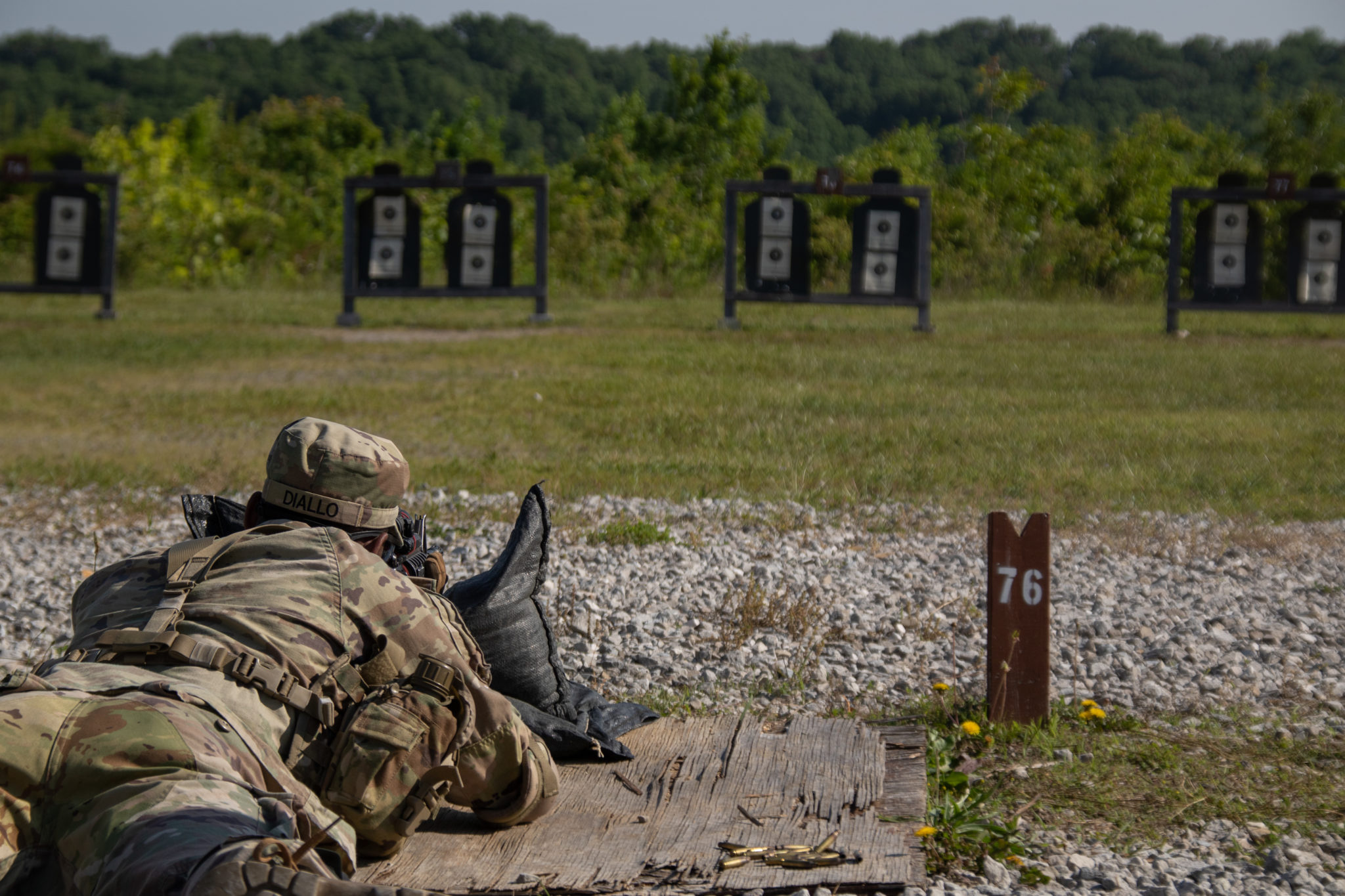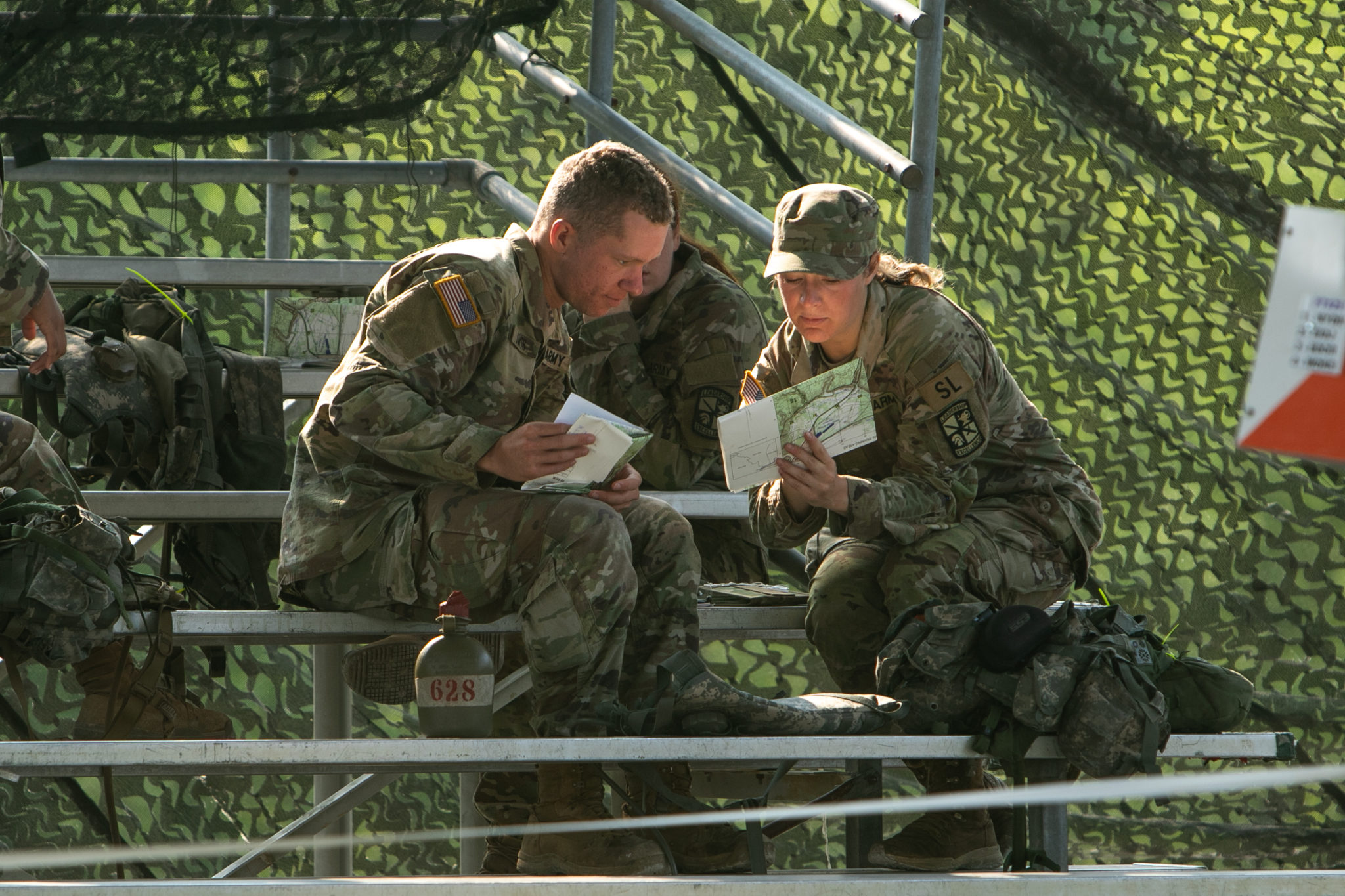By: Madison Thompson
FORT KNOX, Ky. – 8th Regiment, Advanced Camp, executed squad battle drills in Training Area 12, July 18, during Cadet Summer Training at Fort Knox. Squad battle drills are simulated scenarios with specific objectives created to test Cadets in many different ways such as leadership capabilities, movement techniques, and tactical engagement performances.
The first iteration was done at a ‘crawl’ pace. This is where Cadre led Cadets through step by step in objectives. The second iteration of squad battle drills was a movement to contact drill.
“The training we just completed was a react to contact lane. What ended up happening was we were trying to approach an objective but, prior to reaching that objective, made contact with enemy forces. They fired upon us and our job was to try and figure out how to react to it with our Cadre helping us,” said Cadet Michael Orr, McDaniel College, Saint Petersburg, Fla.

8th Regiment, Advanced Camp perform Squad Battle Drills, July 18, during Cadet Summer Training at Fort Knox, Ky. Photo by: Madison Thompson
Cadet Orr explained the squad battle drill farther.
“For the second iteration, what ended up happening was we got everyone up and out of our patrol base … and we started marching through the woods. It got a little dense, so we moved into a file. About 100 meters or so into the wood line, we made contact. At that point, our objective became eliminate the enemy or get them away from us as fast as possible. That way, we can keep pushing on towards our actual objective.”
The enemy forces, in the second iteration, were operated by OPFOR.
“The OP 4 is a training tool. We can train and do Cadre led and Cadre assisted. We do these talk throughs with the Cadets and get them good at these battle drills … It’s harder to really get them how to understand how to array their forces if they don’t have an enemy to face up against,” stated Sgt. 1st Class Justin Butler. “We always bring the OPFOR into the AARs to get a different perspective so the Cadets that executed the operation have a chance to hear the OPFORs perspective and what they saw just from a different vantage point.”
An AAR is an After Action Review or an After Action Report.
“It’s a way for the Cadre and the Cadets to interact with each other post operation … what that does is it lets us learn and lets them say, ‘this is what we came out here to do and this is that I saw.’ It lets you know how the operation went and talk about the lessons learned, things we can do better next time, some of the things that they did really well,” explained Butler.
One thing that was discussed during the AAR was communication. Communication is key for many reasons. It helps inform the other platoon members of what is happening at the point of contact. Communication also can rally forces, troops and weapons if they are needed. It is also important if something goes wrong.

8th Regiment, Advanced Camp perform Squad Battle Drills, July 18, during Cadet Summer Training at Fort Knox, Ky. Cadet and Squad Leader Italia Wilson, Radford University, Ashburn, Va., speaking at After Action Review after second iteration of exercise.
Photo by: Madison Thompson
“Something that definitely was difficult was communication. It’s hard to talk to a group of 30 people when they’re all spread out over 20 or 30 meters and they’re all over the place, especially when things need to happen quickly,” explained Cadet Italia Wilson, Radford University, Ashburn, Va., platoon leader for these drills. “If they don’t know all of the information, they can’t do that. In a real world situation, if I were to go down, the succession of command follows suit from highest ranking to lowest ranking. So, if one of the team members doesn’t know what’s going on, he can’t lead his team properly.”
Platoon movements and exercises like squad battle drills are important for training as well as giving Cadets a controlled environment to practice leadership skills.
“Small unit leaderships is where true leadership really starts,” stated Butler.
In the end, Cadre and Cadets recognized the goals and advice are innumerable.
“Stay motivated. Listen to the Cadre and really listen to tips and advice that are passed on. There’s years and years of experience out here through the NCO support channel and the Officer Corps … take from everybody and constantly learn while you’re here,” said Butler. “The ultimate goal here, at Advanced Camp, should be to go back to your program and train those ones, twos and threes for when they have to come here at

8th Regiment, Advanced Camp perform Squad Battle Drills, July 18, during Cadet Summer Training at Fort Knox, Ky. Photo by: Madison Thompson
Advanced Camp.”
“When it comes to these drills, the biggest thing you can do is … to take them seriously and run them well. I know sometimes you’re in that school mentality and might get a little lazy at times,” stated Orr. “Be sure that you are taking them seriously because, when you get out here, it’s going to be very beneficial. If you’re out here running these lanes and the Cadre see that you know what you’re talking about, it’ll really help you out.”
Cadet Summer Training brings 8,200 Cadets through Basic and Advanced Camp this summer on Fort Knox. These camps are designed to help challenge, grow and improve various skills and leadership qualities within the Cadets. If you think you have what it takes to be a Cadet or if you are interested in a job after college click the following link: https://my.goarmy.com/info/rotc1/index.jsp?iom=IP08-AUTO-R1NA-BR-XXX-XX-XXX-MO-XX-X-BRCMAC:IP08




